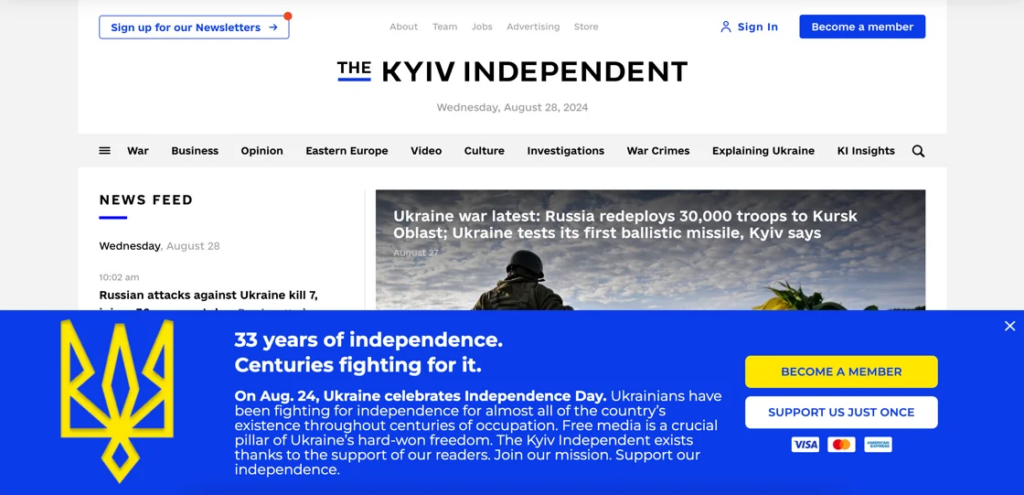You're reading The Audiencers' newsletter #46 sent out on September 4th, 2024. To receive future newsletters straight to your inbox every two weeks, sign up here.
In today’s newsletter:
- Customer-centric pricing & packaging strategies to balance acquisition, retention and revenue
- How to onboard your new subscribers, benchmarks and insights from our workshop
- Lesson’s from The Kyiv Independent on asking for reader support
- The Atlantic: cross-functional collaboration is essential for successful product development
- To add to your reading list
Balancing acquisition, retention & revenue with customer-centric pricing & packaging
When developing pricing and packaging strategies for a subscription product, it’s often tricky to balance contrasting objectives. Maximizing acquisition, increasing revenue, boosting retention… it’s hard to do all these things at once.
According to Jonathon Grant, Senior Director at Simon-Kucher, taking a customer-centric approach to pricing and packaging allows you to minimize these trade offs.
For instance, to balance these goals for acquisition, we need to consider the ‘types’ of features that make up a premium offer.
🍔 The leader benefits: the high value features that drive purchase. You don’t need to include too many of these in a single package. This is the burger in your fast food bundle
🍟 The filler benefits: the medium value, inoffensive features that contribute to the overall value of a bundle. The drink and fries
☕️ The killer benefits: what you don’t want to include! In the fast food example, this could be a coffee. Some people might want to buy a coffee with their fast food bundle, but including it would actually reduce the bundle value for the average customer
You can then run customer research to place different features in each category (below an example from a UK news publisher)
In this example:
🍔 The leader features were the unlimited articles, ad-free experience and access via different platforms
🍟 The fillers were the podcasts, archive access and ability to gift articles
☕️ The killers were the premium newsletters
These outputs were then used to redesign the publisher’s packaging structure to reflect the differences in value of the different features. For example, the leader features were those that became the key differentiators between packages.
How to onboard new subscribers
Just before summer, we ran an intimate workshop event in London, focusing on retention-minded acquisition. Of course, one of the essentials for success in this area is subscriber onboarding.
1. Define the onboarding steps and a goal for each
According to FT Strategies, onboarding steps should be chosen by combining…
- How popular a product is (proxied by the average proportion of users that use it at least once over a 30-day timeframe)
- How impactful a product is on engagement (proxied by how engaged a user of that product is 30 days after using it)
You can then rank features by how ‘likely’ they are to drive adoption and generate engagement, using this to structure your onboarding process accordingly.

2. Segment your new subscribers
By segmenting your new clients, you empower them with the best onboarding experience possible, thus maximizing chances of high retention rates. This segmentation can be simple (the offer they’re subscribing to) or more developed (based on level of engagement, user status such as anonymous vs registered, the data provided, etc).
Find the other onboarding essentials in Marion’s workshop summary.
Lessons from The Kyiv Independent for gaining reader support
The Kyiv Independent monetizes primarily from reader donations, asking for support in a variety of ways across site, carefully balancing frustration and engagement.
> Closable home page banner with a bold message to catch reader attention

> Icons for different payment options, reassuring the reader, and two support options integrated into the banner, reducing a step in the conversion funnel
> Regularly changing design and messaging to reduce blindness to marketing campaigns

> Targeted display to location (see US example), content type (they don’t ask for support on certain articles), after scrolling x% of the page and limited to a set number of displays
> High visibility rate thanks to a variety of modules across site (including at the top and end of articles), whilst also not frustrating the reader with too many pop-ups or blocks
The Atlantic: cross-functional collaboration is essential for successful product development
“In product, and especially in news product, it’s so important for every team to be rowing in the same direction.”
Mariah Craddick, Executive Director of Product at The Atlantic, hits the nail on the head with this phrase as she shares how cross-functional collaboration is essential for successful product development at The Atlantic.
Some key takeaways:
> A clear motivation, and the more rooted in data (whether it’s direct customer feedback or data analysis) the stronger the case for “why”
> Define goals: by setting a clear goal up front, it ensures everyone is on the same page about what the solution is meant to do or what problem it should solve
> Source ideas from everywhere: organize cross-functional brainstorming sessions and sprints
> (Over)communicate: slack, weekly check-ins, shared product development docs… Good communication is often the difference between a successful project and one that stumbles to the finish line
> Share results: spread learnings across the organization, this develops a shared understanding of a product’s impact against the goals and sometimes inspires new ideas for us to pursue
Full article from Mariah shares how The Atlantic put this collaboration into practice when launching features like article gifting.
To add to your reading list
- With tightening regulations, these publishers are already using Cookie Walls to increase consent rates
- Mather Economics Q2 2024 Subscription Benchmarking Report
- The Bristol Cable, the independent, co-operative local news organization, just hit its target to increase membership revenue by £60k in one year! Eliz Mizon, who spoke at The Audiencers’ Festival in London earlier this June, spoke to Journalism.co.uk about their strategy.
The Audiencers’ newsletter: from professionals to professionals
Sign up to our newsletter – real-life examples, expert points of view and inspirations from publishers around the world to help you do your job better. Sent every two weeks.


